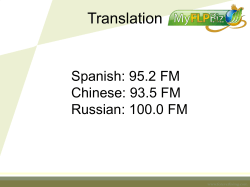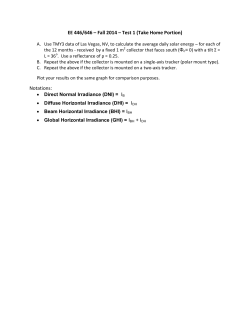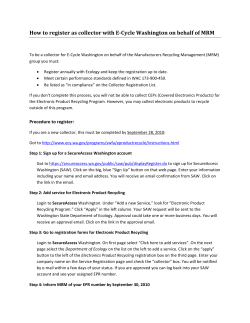
VISHAY CNY74-2 datasheet
CNY74–2H/ CNY74–4H Vishay Telefunken Multichannel Optocoupler with Phototransistor Output Description The CNY74-2H and CNY74-4H consist of a phototransistor optically coupled to a gallium arsenide infrared-emitting diode in an 8-lead, resp. 16-lead plastic dual inline package. The elements are mounted on one leadframe using a coplanar technique, providing a fixed distance between input and output for highest safety requirements. Applications circuits, 14926 non-interacting Features Emitter Coll. D CNY74-2H includes 2 isolater channels D CNY74-4H includes 4 isolater channels D Isolation test voltage VIO = 5 kV D Test class 25/100/21 DIN 40 045 D Low coupling capacitance of typical 0.3 pF D Current Transfer Ratio (CTR) of typical 100% D Low temperature coefficient of CTR D Wide ambient temperature range D Underwriters Laboratory (UL) 1577 recognized, Coll. Emitter 14711 Galvanically separated switches Anode Cath. Cath. Anode 8 PIN 16 PIN file number E-76222 D CSA (C–UL) 1577 recognized, file number E-76222 – Double Protection D Coupling System U C Order Instruction Ordering Code CNY74–2H CNY74–4H Rev. A2, 19–Jul–99 CTR Ranking 50 to 600% 50 to 600% Remarks 8 Pin = Dual channel 16 Pin = Quad channel 1 (9) CNY74–2H/ CNY74–4H Vishay Telefunken Absolute Maximum Ratings Input (Emitter) Parameter Reverse voltage Forward current Forward surge current Power dissipation Junction temperature Test Conditions tp ≤ 10ms Tamb ≤ 25°C Symbol VR IF IFSM PV Tj Value 6 60 1.5 100 125 Unit V mA A mW °C Symbol VCEO VECO IC ICM PV Tj Value 70 7 50 100 150 125 Unit V V mA mA mW °C Symbol VIO 1) Ptot Tamb Tstg Tsd Value 5 250 –40 to +100 –55 to +125 260 Unit kV mW °C °C °C Output (Detector) Parameter Collector emitter voltage Emitter collector voltage Collector current Peak collector current Power dissipation Junction temperature Test Conditions tp/T = 0.5, tp ≤ 10 ms Tamb ≤ 25°C Coupler Parameter Test Conditions AC isolation test voltage (RMS) t = 1 min Total power dissipation Tamb ≤ 25°C Ambient temperature range Storage temperature range Soldering temperature 2 mm from case, t ≤ 10 s 1) Related to standard climate 23/50 DIN 50014 2 (9) Rev. A2, 19–Jul–99 CNY74–2H/ CNY74–4H Vishay Telefunken Electrical Characteristics (Tamb = 25°C) Input (Emitter) Parameter Forward voltage Test Conditions IF = 50 mA Symbol VF Min. Typ. 1.25 Max. 1.6 Unit V Test Conditions IC = 1 mA IE = 100 mA VCE = 20 V, IF = 0, E = 0 Symbol VCEO VECO ICEO Min. 70 7 Typ. Max. Unit V V nA Test Conditions t=2s VIO = 1000 V, 40% relative humidity IF = 10 mA, IC = 1 mA Symbol VIO1) RIO1) Min. 5 Output (Detector) Parameter Collector emitter voltage Emitter collector voltage Collector dark current 100 Coupler Parameter DC isolation test voltage Isolation resistance Collector emitter saturation voltage Cut-off frequency VCE = 5 V, IF = 10 mA, RL = 100 W Coupling capacitance f = 1 MHz 1) Related to standard climate 23/50 DIN 50014 Typ. Max. W 1012 VCEsat Unit kV 0.3 V fc 100 kHz Ck 0.3 pF Current Transfer Ratio (CTR) Parameter IC/IF Test Conditions VCE = 5 V, IF = 5 mA VCE = 5 V, IF = 10 mA Rev. A2, 19–Jul–99 Type Symbol CTR CTR Min. 0.5 0.6 Typ. 1.0 1.2 Max. 6.0 Unit 3 (9) CNY74–2H/ CNY74–4H Vishay Telefunken Switching Characteristics Parameter Delay time Rise time Fall time Storage time Turn-on time Turn-off time Turn-on time Turn-off time IF 0 Test Conditions VS = 5 V, IC = 2 mA, RL = 100 W ((see figure g 1)) Symbol td tr tf ts ton toff ton toff VS = 5 V, IF = 10 mA, RL = 1 kW ((see figure g 2)) Typ. 3.0 3.0 4.7 0.3 6.0 5.0 9.0 18.0 Unit ms ms ms ms ms ms ms ms +5V IF IC = 2 mA ; Adjusted through input amplitude RG = 50 W tp = 0.01 T tp = 50 ms 96 11698 IF 0 Channel I 50 W 100 Channel II W t tp Oscilloscope RL = 1 M W CL = 20 pF 95 10804 IC 100% 90% Figure 1. Test circuit, non-saturated operation 10% 0 IF 0 IF = 10 mA td IC RG = 50 W tp 0.01 T + ts ton tp = 50 ms Channel I 50 W Channel II 1 kW t tr +5V Oscilloscope RL ≥ 1 MW CL ≤ 20 pF tp td tr ton (= td + tr) tf toff pulse duration delay time rise time turn-on time ts tf toff (= ts + tf) storage time fall time turn-off time Figure 3. Switching times 95 10843 Figure 2. Test circuit, saturated operation 4 (9) Rev. A2, 19–Jul–99 CNY74–2H/ CNY74–4H Vishay Telefunken Typical Characteristics (Tamb = 25_C, unless otherwise specified) 10000 Coupled device ICEO– Collector Dark Current, with open Base ( nA ) P tot – Total Power Dissipation ( mW ) 300 250 200 Phototransistor 150 IR-diode 100 50 VCE=20V IF=0 1000 100 10 0 1 0 40 80 120 Tamb – Ambient Temperature ( °C ) 96 11700 0 100 IC – Collector Current ( mA ) I F – Forward Current ( mA ) 100.0 10.0 1.0 0.1 VCE=5V 10 1 0.1 0.01 0 0.2 0.4 0.6 0.8 1.0 1.2 1.4 1.6 1.8 2.0 VF – Forward Voltage ( V ) 96 11862 0.1 100 10 Figure 8. Collector Current vs. Forward Current 2.0 100 20mA IC – Collector Current ( mA ) VCE=5V IF=5mA 1.5 1.0 0.5 0 –25 1 IF – Forward Current ( mA ) 95 11027 Figure 5. Forward Current vs. Forward Voltage CTR rel – Relative Current Transfer Ratio 100 75 Figure 7. Collector Dark Current vs. Ambient Temperature 1000.0 95 11025 50 Tamb – Ambient Temperature ( °C ) 95 11026 Figure 4. Total Power Dissipation vs. Ambient Temperature 25 IF=50mA 10mA 10 5mA 2mA 1 1mA 0.1 0 25 50 75 Tamb – Ambient Temperature ( °C ) Figure 6. Relative Current Transfer Ratio vs. Ambient Temperature Rev. A2, 19–Jul–99 0.1 95 10985 1 10 100 VCE – Collector Emitter Voltage ( V ) Figure 9. Collector Current vs. Collector Emitter Voltage 5 (9) CNY74–2H/ CNY74–4H 1.0 t on / t off – Turn on / Turn off Time ( m s ) VCEsat – Collector Emitter Saturation Voltage ( V ) Vishay Telefunken 20% 0.8 CTR=50% 0.6 0.4 0.2 10% 0 1 toff 20 10 ton 0 5 100 10 15 20 Figure 12. Turn on / off Time vs. Forward Current t on / t off – Turn on / Turn off Time ( m s ) VCE=5V 10 IF – Forward Current ( mA ) 95 11031 1000 CTR – Current Transfer Ratio ( % ) 30 100 10 IC – Collector Current ( mA ) Figure 10. Collector Emitter Saturation Voltage vs. Collector Current 1 10 8 Non Saturated Operation VS=5V RL=100W ton 6 toff 4 2 0 0.1 1 10 100 IF – Forward Current ( mA ) Figure 11. Current Transfer Ratio vs. Forward Current 6 (9) Saturated Operation VS=5V RL=1kW 40 0 95 11028 95 11029 50 0 95 11030 2 4 6 10 IC – Collector Current ( mA ) Figure 13. Turn on / off Time vs. Collector Current Rev. A2, 19–Jul–99 CNY74–2H/ CNY74–4H Vishay Telefunken Type XXXXXXXX Date Code (YM) 820 U TFK 63 15091 Pin 1 Indication Coupling System Indicator Company Logo Production Location Figure 14. Marking example Dimensions of CNY74–2 in mm y y weight: ca. 0.55 g creepage distance: 6 mm air path: 6 mm after mounting on PC board 14784 14784 Rev. A2, 19–Jul–99 7 (9) CNY74–2H/ CNY74–4H Vishay Telefunken Dimensions of CNY74–4 in mm y y weight: ca. 1.0 g creepage distance: 6 mm air path: 6 mm after mounting on PC board 14783 8 (9) Rev. A2, 19–Jul–99 CNY74–2H/ CNY74–4H Vishay Telefunken Ozone Depleting Substances Policy Statement It is the policy of Vishay Semiconductor GmbH to 1. Meet all present and future national and international statutory requirements. 2. Regularly and continuously improve the performance of our products, processes, distribution and operating systems with respect to their impact on the health and safety of our employees and the public, as well as their impact on the environment. It is particular concern to control or eliminate releases of those substances into the atmosphere which are known as ozone depleting substances ( ODSs ). The Montreal Protocol ( 1987 ) and its London Amendments ( 1990 ) intend to severely restrict the use of ODSs and forbid their use within the next ten years. Various national and international initiatives are pressing for an earlier ban on these substances. Vishay Semiconductor GmbH has been able to use its policy of continuous improvements to eliminate the use of ODSs listed in the following documents. 1. Annex A, B and list of transitional substances of the Montreal Protocol and the London Amendments respectively 2 . Class I and II ozone depleting substances in the Clean Air Act Amendments of 1990 by the Environmental Protection Agency ( EPA ) in the USA 3. Council Decision 88/540/EEC and 91/690/EEC Annex A, B and C ( transitional substances ) respectively. Vishay Semiconductor GmbH can certify that our semiconductors are not manufactured with ozone depleting substances and do not contain such substances. We reserve the right to make changes to improve technical design and may do so without further notice. Parameters can vary in different applications. All operating parameters must be validated for each customer application by the customer. Should the buyer use Vishay Telefunken products for any unintended or unauthorized application, the buyer shall indemnify Vishay Telefunken against all claims, costs, damages, and expenses, arising out of, directly or indirectly, any claim of personal damage, injury or death associated with such unintended or unauthorized use. Vishay Semiconductor GmbH, P.O.B. 3535, D-74025 Heilbronn, Germany Telephone: 49 ( 0 ) 7131 67 2831, Fax number: 49 ( 0 ) 7131 67 2423 Rev. A2, 19–Jul–99 9 (9)
© Copyright 2025





















